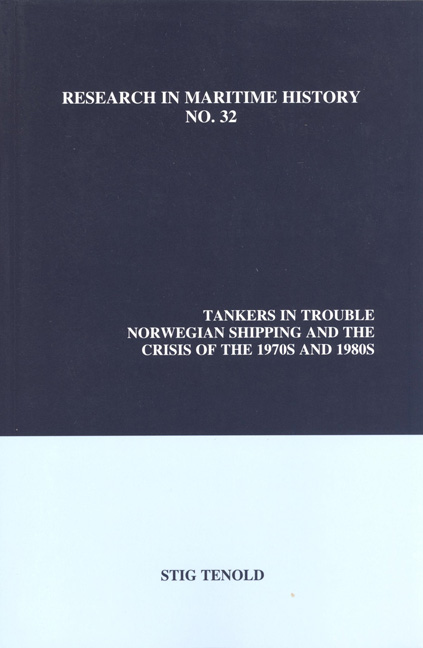Book contents
- Frontmatter
- Table of Contents
- List of Tables in the Text
- List of Illustrations
- Preface
- Chapter 1 Introduction
- Chapter 2 The Shipping Market after World War II
- Chapter 3 The Basis of the Tanker Crisis
- Chapter 4 The Contagion and Short-term Effects of the Crisis
- Chapter 5 Stage Two of the Crisis and the Long-term Changes
- Chapter 6 The Basis for the Crisis in Norwegian Shipping
- Chapter 7 Structural Transformations in Norwegian Shipping
- Chapter 8 The Fates of Four Norwegian Shipowners
- Chapter 9 Conclusion
- Appendices
- Bibliography: Select Bibliography
Chapter 3 - The Basis of the Tanker Crisis
- Frontmatter
- Table of Contents
- List of Tables in the Text
- List of Illustrations
- Preface
- Chapter 1 Introduction
- Chapter 2 The Shipping Market after World War II
- Chapter 3 The Basis of the Tanker Crisis
- Chapter 4 The Contagion and Short-term Effects of the Crisis
- Chapter 5 Stage Two of the Crisis and the Long-term Changes
- Chapter 6 The Basis for the Crisis in Norwegian Shipping
- Chapter 7 Structural Transformations in Norwegian Shipping
- Chapter 8 The Fates of Four Norwegian Shipowners
- Chapter 9 Conclusion
- Appendices
- Bibliography: Select Bibliography
Summary
When discussing the properties of a crisis - whether in shipping or elsewhere - it is sometimes difficult to distinguish between cause and effect. For instance, if we focus on the aggregate level and define the shipping crisis as a mismatch between demand and supply, plummeting freight rates become an effect. But if we consider the plight of shipowners and regard falling profitability as the crisis, the low level of freight rates was a cause rather than an effect. Consequently, it might be fruitful to discuss what constitutes a crisis.
A traditional definition of a depression or slump is that it is characterised by underutilisation of the factors of production and falling demand. In shipping, underutilisation of the capital stock is common. Unlike manufacturing, the shipping industry cannot easily accumulate inventory for future sale. If supply exceeds demand, this is reflected in lower rates. If rates fall below a certain level, ships have to be laid-up, and laid-up ships imply that the capital stock is not being utilised fully.
Even during the so-called “golden age,” there were more than six lean months for every fat one. These slim periods were characterised by a surplus of tonnage relative to demand. Indeed, in the late 1950s between seven and eight percent of the dry bulk fleet was laid-up, a rate twice as high as during the shipping crisis of the 1970s. Oversupply of tonnage is a typical example of the underutilisation of resources. Yet despite the fact that prior to 1973 large numbers of ships had sometimes been idle, only in 1958 was this associated with falling demand.
Crises discourage investment in new capacity, but before the 1970s there was substantial investment in shipping. The world fleet grew annually, and rapid technological development led to substantial improvements in the capital stock. Vessels became larger, more specialised and more sophisticated. The large amounts of new tonnage led to a decline in average age. Favourable demand made new investments attractive despite temporary overcapacity.
Thus, any talk of a crisis in postwar shipping before 1973 is inappropriate. The periods of overcapacity were too short to have had significant effects on long-term profitability or on the structure of the industry.
- Type
- Chapter
- Information
- Tankers in TroubleNorwegian Shipping and the Crisis of the 1970s and 1980s, pp. 17 - 64Publisher: Liverpool University PressPrint publication year: 2006



